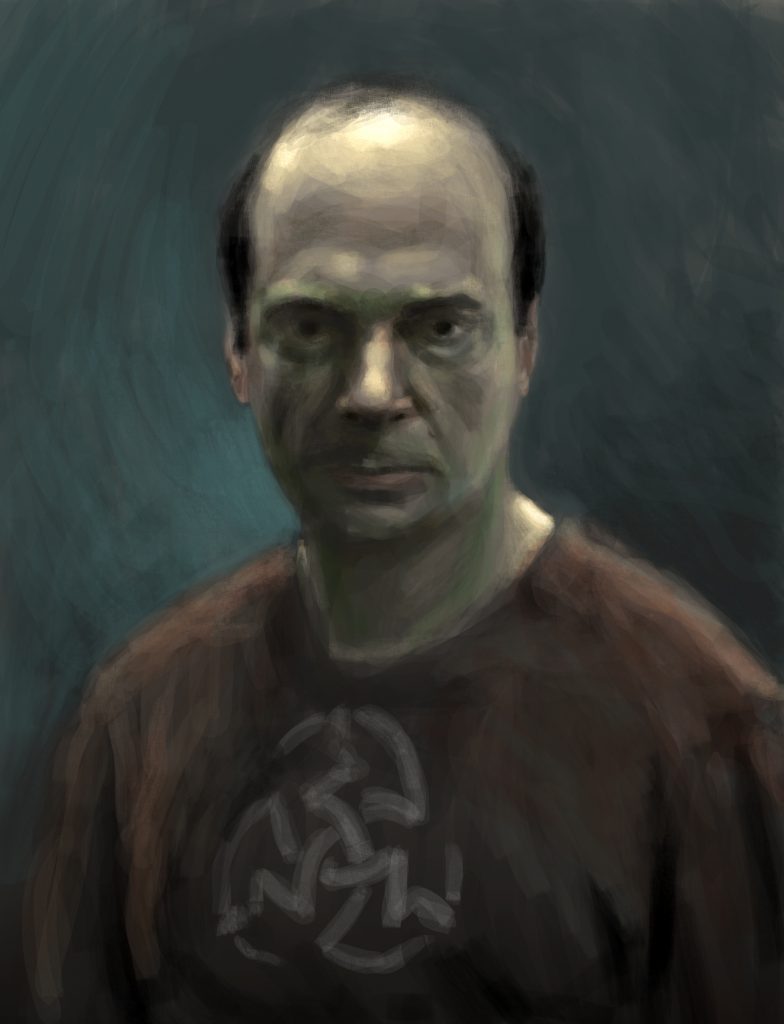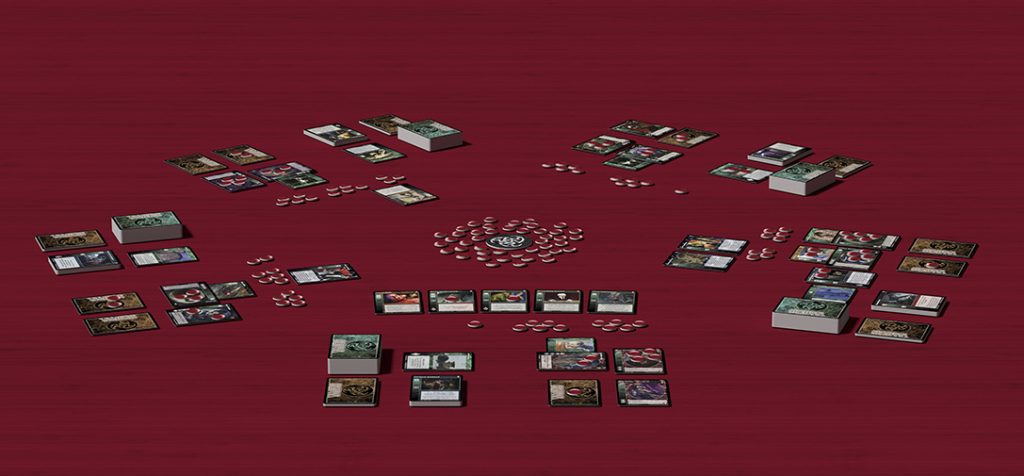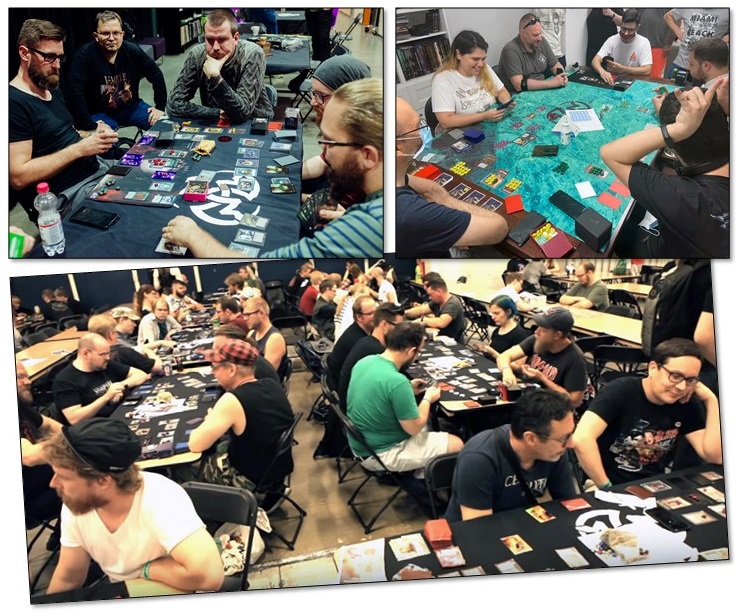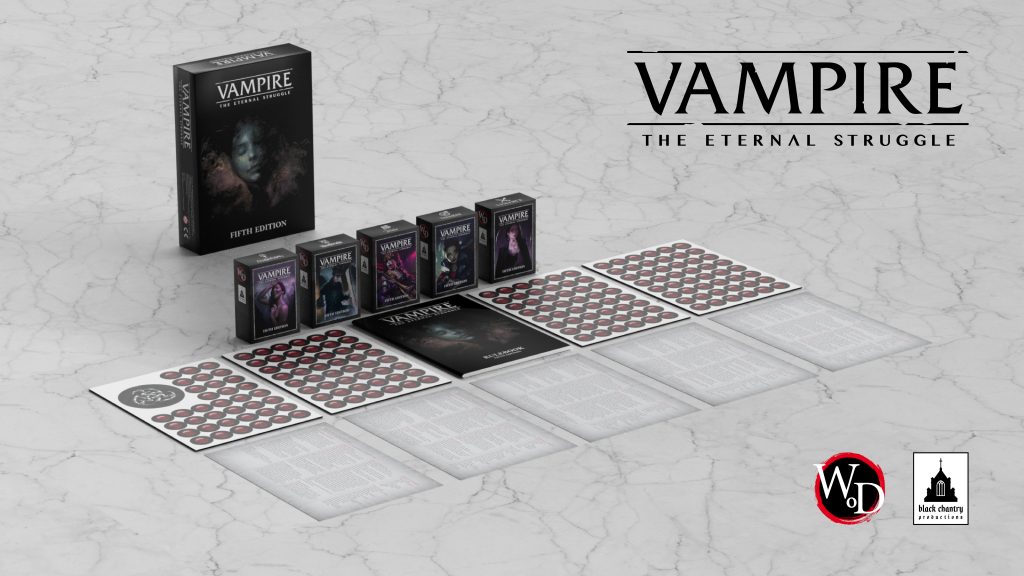Fifth Edition now in stores – An interview with original designer Richard Garfield

Vampire: The Eternal Struggle Fifth Edition is now in stores! It´s been a long time since the original game designer Richard Garfield was involved in the game – he has been busy with many other creations; Magic: The Gathering, Netrunner, Roborally, King of Tokyo, Keyforge, to name a few. We at Black Chantry Productions of course owe him enormous gratitude and we wanted to ask him some questions about the game and game design in general. Gladely, he agreed to answer!
Let´s start from the beginning, back in the early 90´s. How did Vampire: The Eternal Struggle begin?
– When Magic: The Gathering was published and a great success, the first publisher Wizards of the Coast was completely on board with the idea that trading card games were a new form of game, of which there could be many versions. They anticipated many trading card games made within the hobby industry and we wanted to use our expertise to make some of them. I think the first license we got was with White Wolf for a game set in their World of Darkness. I was more interested in working on a new trading card game than working on Magic, so I threw myself into this project – and it became my first design based on another company´s world.
I probably couldn’t have had a better license to work with – role playing worlds are very deep so there are a lot of resources to use for a card game, and those resources were flavorful and filled with exciting possibilities. The company we were working with, White Wolf, was open to reinterpreting and adding elements to the world that would make it as good as possible for the card game. In future projects I would learn that this was not always the case, some companies are less interested in the card product being good than it reflecting other expressions of the world. I did my part as well as I could – trying to honor the spirit of the World of Darkness with as few impositions as possible.
I don’t remember ever getting any pushback on the designs, though it is long enough ago that I might not remember. It certainly must have helped that many people at Wizards were enthusiasts of the World of Darkness and so I could check my work without necessarily involving White Wolf.

How did you feel about the assignment back then? How was the mood in the team?
– I think we worked hard but I don’t remember hurrying. As a personal goal, I wanted to explore the possibilities trading card games had to offer – I was not interested in using standards created by Magic. It was exciting testing the possibilities this game form opened up – and it was a really new experience for me to be limited by someone else’s world but at the same time have so many world resources to draw on.
Since that time, I have learned to appreciate standards that have been laid down by previous designs as useful not only for the designers and developers – but also the players. Were I to go back now I would think twice about changes to this game relative to Magic – making sure it was worth the player learning something new in each place that I broke the norms. However, I doubt I would have reigned myself in much, the temptation to explore was probably too great – and, honestly, the players probably wanted to see what else was possible as well.
The “replace each played card immediately”-mechanic in Vampire: The Eternal Struggle is rather odd and stumps many who are used to other card games. How did you come up with that?
– I believe it is only odd because it breaks the standard that Magic presents. There are many ways to manage hand size, and I played with many of them in various prototypes – including systems like are used in deckbuilders today – where you draw a complete new hand every turn, or like we see in Keyforge – where players fill their hand to a particular size at the end of their turn. It is good to see some variation in these methods because the method of accessing cards can dominate the sorts of strategies that emerge. Immediate replacement makes the game more about using what you have as best you can – rather than saving it to the best effect.

Nowadays, we use a 2-hour time limit for games in tournaments, but in the first rulebook there was no time limit. How long did you expect a game to take?
– I estimated that it was about half an hour per player – at least that is what I remember, things have changed a lot since then. It certainly was not designed for tournaments, though any game players love to play can be adapted in some way or another for that purpose. A game played in a tournament typically needs to make some sort of time rule.
While I think a half hour per player is a fine length for boardgame standards I think it is also something that somewhat undercuts Vampire: The Eternal Struggle as a trading card game. After its publication I realized and began to appreciate the ability to play many games of Magic in a sitting and modify my deck between and missed that in Vampire: The Eternal Struggle – where the games typically ran too long to do that. Once people are into a game – that is fine – the time frame over which they modify their deck is just longer. But when people are getting into the game, if they only play it once they are missing one of the fundamental parts of a trading card game – varying your tools.
How do you remember the first reception of the game?
– I remember mixed reactions. Part of this is inevitable, we were just learning back then how one could not measure a trading card game against Magic’s success, that it was almost always going to fall short. The other negative reaction would have come from some enthusiasts of the World of Darkness who were role playing devotees, and while they may have been excited about a product like this in principle, role playing and tactical style card games like this are two very different things, and there were bound to be players who didn’t want to do both.
On the other hand – there were a lot of players who didn’t care for the two player nature of Magic, who liked the flavor of the World of Darkness and were keen to experience that as opposed to Magic, and who liked more lengthy and deep play sessions that hours gave them rather than the 20 minutes a Magic game would have. These players flocked to the game and found something they liked a lot – and many of them have made it clear to me that it is a favorite of theirs that they always return to given the opportunity.

How come you left design of the first expansions to other people?
– For the same reason I left Magic design, I was more interested in seeing what else could be done with trading card games than what could be done with a trading card game that had already been designed. Also, I believed that for any game like this to reach its potential it was required to get more people in on the design and my presence on the team would limit them. I made myself available for feedback on all the games I started but I wanted designers to take ownership.
There are a lot of rumours about what order your first games were designed, of what came first and took ideas from what etc. What is the true order of those first games – Magic, Vampire, Roborally, Netrunner, etc.?
– Roborally was designed first, then Magic, Vampire, Netrunner, Battletech… and somewhere in there was Great Dalmuti. Maybe after Magic. It is always guesswork, however, because my designs always are influenced by each other and the roots go back very far – so – for example – my first Magic themed games that had some of the trappings of Magic appeared about the time I was first doing the Robot themed battle and race games that became Roborally.

What do you think distinguishes Vampire: The Eternal Struggle from other similar games?
– As far as I know this was the first game that used ‘attacking left’ as a rule to allow a large group of players to play a very interactive game without being dominated by politics of who to attack. We certainly tried this in Magic, but it wasn’t a very big part of the game, and, of course, Vampire: The Eternal Struggle was built around it. It never really caught on with Magic, the more social games are generally more free-for-all, but I think giving players natural targets makes the game more social. I know that when I play a very interactive game, I don’t want to target anyone because I don’t want to make enemies – and that is not a fun way to play if everyone plays that way. Giving me a target gives me a place to start.
I think this game was unusual in the length of time it allowed itself. As I mentioned above – I think in general that is the wrong decision for a trading card game, but it has its merits – you can get a game that feels more epic when you play it. If Magic is a hand of poker, Vampire: The Eternal Struggle is a poker tournament.
Are there things that you think were especially good in Vampire: The Eternal Struggle that you have used in later games too?
– The attack left mechanic – certainly – is one that comes up again and again. It isn’t a cure-all for the problems with a free-for-all game, but it is a good place to start and for a casual player it is just fine.
Something I particularly liked in Vampire: The Eternal Struggle that I have not used since, but will if appropriate, was the voting. I liked the flavor and mechanics of cards being put up for vote during play.

During 2019, 210 sanctioned Vampire: The Eternal Struggle tournaments were played all over the world. Some annual tournaments have over 100 players. Black Chantry Productions has published the game in English, Brazilian Portuguese, Spanish and French, and Italian and more translations are coming. Why do you think the game is still played, all over the world, 25 years after its birth?
– I guess the flavor and strategy built into the game spoke to a lot of players and didn’t have much offered in the same game-space. It is gratifying to see my work have such endurance and I am happy some players take pleasure in it.
We thank Richard Garfield for these answers and wish him good luck with his current endeavors, most recently the trivia game Half Truth together with Ken Jennings, and his ongoing project Keyforge.

Vampire: The Eternal Struggle Fifth Edition is available for all stores and distributors. For more information please visit www.blackchantry.com. Contact us by mail or social media.
Vampire: The Eternal Struggle Fifth Edition designers: Ben Peal, Mike Nudd, and Ginés Quiñonero.
Copyright © 2025 Paradox Interactive AB. www.paradoxinteractive.com. All rights reserved. Vampire: The Eternal Struggle and Vampire: The Masquerade® are trademarks and/or registered trademarks of Paradox Interactive AB. All rights reserved.
